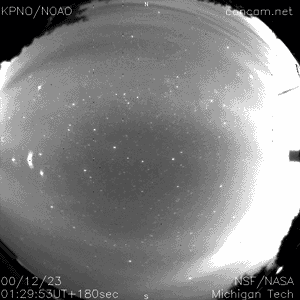871
SIFCO of nature)




















I saw a man, if he could look at the sky, not looking, the whole night? When it comes to sky over Kitt Peak National Observatory 23 December 2000, the answer to this question gives demonstrated here cranking obtained using installed at the observatory operate continuously chamber (CONtinuous CAMera abbreviated CONCAM). The first thing that catches the eye is the apparent rotation of the stars around the North Star, which is located near the top of the image. In fact, under the fixed sky Earth rotates together with the fixed camera on it. Diffuse band of light that moves across the frame, is nothing more than a central disk of our Milky Way Galaxy. Among the moving objects is not difficult to find all the familiar constellation of Orion, the individual stars (eg Sirius and Betelgeuse) and planets (Jupiter and Saturn). The project CONCAM astronomical Web cameras have been installed at major observatories for continuous monitoring of air and attract large telescopes to meet the challenges of remote weather monitoring.




Why do these stars are moving so fast? Demonstrated here cranking infrared captured moving stars over the past eight years in the field of a few light-years away in the center of our galaxy. Yellow with a cross in the center of the frame marks the position of unusual radio source called Sagittarius A *. If the images are retained stars near the galactic center by gravity, the source of the gravitational field must be compact and robust. From the analysis of stellar motions shows that in less than one fifth the size of the light, the mass of lies, at least five million times the sun. According to astronomers, these observations provide a reliable proof of the existence of a supermassive black hole at the center of our galaxy.

























